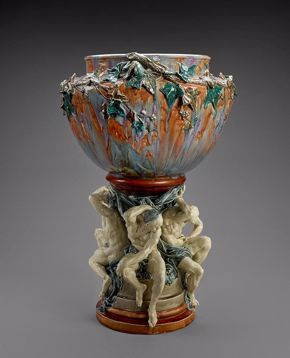Collection Spotlight: A Fusion of Forms February 15, 2020

Albert-Ernest Carrier-Belleuse and Auguste Rodin, The Vase of the Titans, 1899, glazed polychromed terracotta, the Museum of Fine Arts, Houston, Museum purchase funded by Fayez Sarofim in honor of his wife, Susan, and children, Christopher, Allison, Andrew, and Phillip at “One Great Night in November, 2018.”
Auguste Rodin, Titan IV, late 1870s, terracotta, the Museum of Fine Arts, Houston, the Robert Lee Blaffer Memorial Colection, gift of Sarah Campbell Blaffer.
Auguste Rodin, Titan II, late 1870s, terracotta, the Museum of Fine Arts, Houston, the Robert Lee Blaffer Memorial Collection, gift of Sarah Campbell Blaffer.
Showing a fascinating fusion of fine and decorative art, The Vase of the Titans exhibits an amalgamation of the styles of two prominent artists—one, the master; the other, the apprentice whose name would eventually overshadow that of his teacher.
This polychrome terracotta vase is signed by Albert-Ernest Carrier-Belleuse, one of the most productive French sculptors and ceramicists of the 19th century. However, his pupil Auguste Rodin sculpted the four Titans, mythological giants conquered by the gods of Olympus, who sit on a plinth, doomed for an eternity to support the hefty vessel.
The contributions of both artists to this rare work—only five versions are known to survive intact—make it a masterpiece.
A Carnival of Colors
Carrier-Belleuse’s admiration of the past can be seen in the majestic form of The Vase of the Titans, and his novelty and wit expressed in its decoration. An exquisite petite frog looks ready to leap into the vase, its thin, delicate phalanges resting on the bowl’s lip. Another frog dodges behind ivy leaves and twigs. The lustrous glaze drips with a carnival of colors in orange, lavender, blue, and green; it also indicates the pioneering glaze techniques that were being developed at the time this version was fired in 1899.
A Devotion to Michelangelo
The base, created in 1878, is clearly by Rodin, who furthered the concept of a vase Carrier-Belleuse had created as a designer at the Minton ceramic factory in England. Rodin added the Titans and imbued them with a high degree of spatial complexity and natural physicality reminiscent of Michelangelo’s figures on the ceiling of the Sistine Chapel. Rodin’s sculptures, like the Titans on this vase, demonstrate his departure from academic sculpture and his devotion to Michelangelo’s work.
A Turning Point
The sculptures mark a turning point in Rodin’s vision—when he fully focused on natural postures that showed passion, emotion, and character and used textured surfaces to facilitate the interplay of light and shadows. By 1900, shortly after the production of this vase, Rodin’s remarkable talent established his reputation as the most important sculptor of the modern era.
► See “The Vase of the Titans” on the second floor of the Beck Building.





